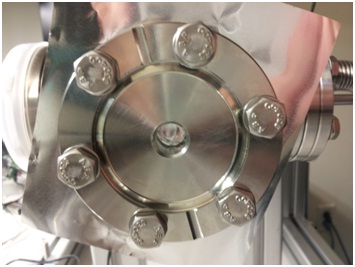Exit Window
The aim of the exit window is to allow the electron beam to leave the electron accelerator in order to bombard the target (e.g. electrolytic solution for radiation chemistry). This requires a special type of exit window that will allow the electrons to pass by, while maintaining the pressure difference and not allowing air to leak into the system.
 Exit window: aluminum foil sandwiched between two flanges. Stresses on the middle of the foil can be seen.
Exit window: aluminum foil sandwiched between two flanges. Stresses on the middle of the foil can be seen.
In actual accelerator designs, these windows are usually made of a thin metal foil. The two most commonly used foils are aluminum and a material known as Havar, composed of iron, chromium, cobalt, nickel and a few other additive metals. Havar is advertised as a high-strength non-magnetic alloy that keeps its strength even at very high temperatures. It is commonly used in high current beam lines where the number of accelerated particles is high enough to produce large amounts of heat. As the beam current for MEGA is very low, strength at high temperatures is not required. Additionally, one sheet of Havar foil can cost up to $1000. At this price, the team decided to use a 99% pure aluminum sheet as the metal exit window.
 Exit window: aluminum foil sandwiched between two flanges. Stresses on the middle of the foil can be seen.
Exit window: aluminum foil sandwiched between two flanges. Stresses on the middle of the foil can be seen.
|
